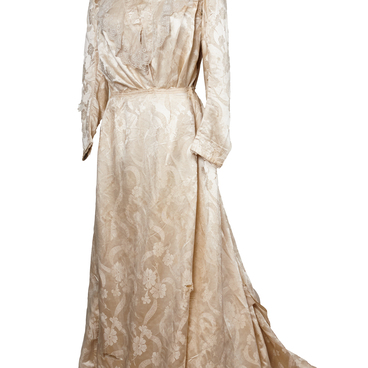The museum collection houses a ball of goldwork thread of the 19th century. Gorodets was one of the centers of gold embroidery in the Nizhny Novgorod governorate along with Arzamas, Lyskovo, the village of Varnavino on Vetluga and Nizhny Novgorod itself. Therefore, this is a very special exhibit of the collection.
People have used goldwork thread for embroidery since ancient times. Gold embroidery is first mentioned as early as in the 2nd century BC. In Rus', gold embroidery was used to decorate the garments of tsars, princes and boyars (the second highest rank after the princes), as well as vestments and many church items. These clothes were worn only on exceptional occasions — whether it was an ascension to the throne or a ceremonial service.
An important milestone in the history of gold embroidery was the baptism of Rus' in 988. With the adoption of Christianity, there was a need to provide churches with appropriate items for divine services. In this respect, Rus' inherited the Byzantine tradition, which assumed magnificent festive services and appropriate surroundings. Clerical garment was to shine like gold, so the Russian craftswomen took up a new business — goldwork embroidery. For a long time, this craft existed only in monasteries. It became a part of secular culture later.
As a rule, metallized gold and silver threads were used for gold embroidery. The metal was turned into a very thin wire, and linen or silk threads were wrapped around it. Sometimes, though, the wire itself was used for broidery. Embroidery was done on expensive thick fabrics — taffeta, satin, brocade, velvet, as well as on suede and leather. It was additionally decorated with pearls and gems. For this reason, both the materials for the work and the finished products were extremely expensive. Most of the products that have survived to this day are primarily church items: icons, sewn iconostases, banners.
Over the years, pure gold was replaced with gilded silver, which was wrapped around yellow silk threads. In the 18th century, when this form of craft reached its heyday, hand spinning was replaced by mechanical spinning. In the 19th century, people began to use gilded copper thread. However, no matter how the gold thread was produced, it was always extremely expensive. Gold-woven embroidery was present on the ceremonial dresses of the members of the imperial house. It was often given as a gift. The poet Alexander Pushkin is known to have sent gold-woven belts as a gift to Princess Vyazemskaya and joked that ‘she will surpass all the beauties in Moscow (literally “stick everyone behind her belt” — ed.) when she puts on my belts’.
People have used goldwork thread for embroidery since ancient times. Gold embroidery is first mentioned as early as in the 2nd century BC. In Rus', gold embroidery was used to decorate the garments of tsars, princes and boyars (the second highest rank after the princes), as well as vestments and many church items. These clothes were worn only on exceptional occasions — whether it was an ascension to the throne or a ceremonial service.
An important milestone in the history of gold embroidery was the baptism of Rus' in 988. With the adoption of Christianity, there was a need to provide churches with appropriate items for divine services. In this respect, Rus' inherited the Byzantine tradition, which assumed magnificent festive services and appropriate surroundings. Clerical garment was to shine like gold, so the Russian craftswomen took up a new business — goldwork embroidery. For a long time, this craft existed only in monasteries. It became a part of secular culture later.
As a rule, metallized gold and silver threads were used for gold embroidery. The metal was turned into a very thin wire, and linen or silk threads were wrapped around it. Sometimes, though, the wire itself was used for broidery. Embroidery was done on expensive thick fabrics — taffeta, satin, brocade, velvet, as well as on suede and leather. It was additionally decorated with pearls and gems. For this reason, both the materials for the work and the finished products were extremely expensive. Most of the products that have survived to this day are primarily church items: icons, sewn iconostases, banners.
Over the years, pure gold was replaced with gilded silver, which was wrapped around yellow silk threads. In the 18th century, when this form of craft reached its heyday, hand spinning was replaced by mechanical spinning. In the 19th century, people began to use gilded copper thread. However, no matter how the gold thread was produced, it was always extremely expensive. Gold-woven embroidery was present on the ceremonial dresses of the members of the imperial house. It was often given as a gift. The poet Alexander Pushkin is known to have sent gold-woven belts as a gift to Princess Vyazemskaya and joked that ‘she will surpass all the beauties in Moscow (literally “stick everyone behind her belt” — ed.) when she puts on my belts’.



